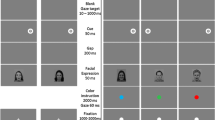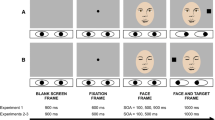Abstract
We investigated the effect of emotional target content on the generation of pro- and anti-saccades. Subjects had to generate saccades towards (pro-saccade) or away from (anti-saccade) peripherally presented pleasant, unpleasant or neutral pictures. Two different SOAs were used, either with simultaneous fixation offset and target onset (no gap) or with fixation offset preceding target onset by 200 ms (gap). In the pro-saccade task participants were faster to respond to emotional pictures in the left visual field. In the right visual field facilitation occurred only for pleasant pictures and saccadic reaction times towards unpleasant pictures were slowed. In the anti-saccade task more anti-saccade errors towards emotional pictures (pleasant and unpleasant) were made in the gap condition. On the whole, endogenous saccade generation appears facilitated by emotional target content, probably via increased input from extra-striate and parietal brain areas to the superior colliculus. Moderating factors such as the SOA or the visual field of presentation are discussed.


Similar content being viewed by others
References
Adolphs R, Jansari A, Tranel D (2001) Hemispheric perception of emotional valence from facial expressions. Neuropsychology 15:516–524
Becker MW, Pashler H, Lubin J (2007) Object-intrinsic oddities draw early saccades. J Exp Psychol Hum Percept Perform 33:20–30
Calvo MG, Lang PJ (2005) Parafoveal semantic processing of emotional visual scenes. J Exp Psychol Hum Percept Perform 31:502–519
Cuthbert BN, Schupp HT, Bradley MM, Birbaumer N, Lang PJ (2000) Brain potentials in affective picture processing: covariation with autonomic arousal and affective report. Biol Psychol 52:95–111
Dorris MC, Munoz DP (1998) Saccadic probability influences motor preparation signals and time to saccadic initiation. J Neurosci 18:7015–7026
Fecteau JH, Munoz DP (2006) Salience, relevance, and firing: a priority map for target selection. Trends Cogn Sci 10:382–390
Gilchrist ID, Proske H (2006) Anti-saccades away from faces: evidence for an influence of high-level visual processes on saccade programming. Exp Brain Res 173:708–712
Hallett PE (1978) Primary and secondary saccades to goals defined by instructions. Vision Res 18:1279–1296
Haxby JV, Ungerleider LG, Clark VP, Schouten JL, Hoffman EA, Martin A (1999) The effect of face inversion on activity in human neural systems for face and object perception. Neuron 22:189–199
Hugdahl K, Iversen PM, Ness HM, Flaten MA (1989) Hemispheric differences in recognition of facial expressions: a VHF-study of negative, positive, and neutral emotions. Int J Neurosci 45:205–213
Ikeda T, Hikosaka O (2003) Reward-dependent gain and bias of visual responses in primate superior colliculus. Neuron 39: 693–700
Junghofer M, Bradley MM, Elbert TR, Lang PJ (2001) Fleeting images: a new look at early emotion discrimination. Psychophysiology 38:175–178
Keil A, Müller MM, Gruber T, Wienbruch C, Stolarova M, Elbert T (2001) Effects of emotional arousal in the cerebral hemispheres: a study of oscillatory brain activity and event-related potentials. Clin Neurophysiol 112:2057–2068
Keil A, Bradley MM, Hauk O, Rockstroh B, Elbert T, Lang PJ (2002) Large-scale neural correlates of affective picture processing. Psychophysiology 39:641–649
Killgore WDS, Yorgelun-Todd DA (2007) The right hemisphere and valence hypotheses: could they both be right (and sometimes left)? Soc Cogn Affect Neurosci 2:240–250
Kimura Y, Yoshino A, Takahashi Y, Nomura S (2004) Interhemispheric difference in emotional response without awareness. Physiol Behav 82:727–731
LaBar KS, Mesulam M, Gitelman DR, Weintraub S (2000) Emotional curiosity: modulation of visuospatial attention by arousal is preserved in aging and early-stage Alzheimer’s disease. Neuropsychologia 38:1734–1740
Lang PJ, Bradley MM, Cuthbert BN (1999, 2005) International affective picture system (IAPS): digitized photographs, instruction manual and affective ratings. Technical report A-6. University of Florida, Gainesville, FL
Massen C (2004) Parallel programming of exogenous and endogenous components in the antisaccade task. Q J Exp Psychol A 57:475–498
Milstein DM, Dorris MC (2007) The influence of expected value on saccadic preparation. J Neurosci 27:4810–4818
Miltner WH, Krieschel S, Hecht H, Trippe R, Weiss T (2004) Eye movements and behavioral responses to threatening and nonthreatening stimuli during visual search in phobic and nonphobic subjects. Emotion 4:323–339
Munoz DP, Wurtz RH (1992) Role of the rostral superior colliculus in active visual fixation and execution of express saccades. J Neurophysiol 67:1000–1002
Munoz DP, Everling S (2004) Look away: the anti-saccade task and the voluntary control of eye movement. Nature Rev Neurosci 5:218–228
Natale M, Gur RE, Gur RC (1983) Hemispheric asymmetries in processing emotional expressions. Neuropsychologia 21:555–565
Nummenmaa L, Hyona J, Calvo MG (2006) Eye movement assessment of selective attentional capture by emotional pictures. Emotion 6:257–268
Rinck M, Becker ES (2006) Spider fearful individuals attend to threat, then quickly avoid it: evidence from eye movements. J Abnorm Psychol 115:31–238
Saslow MG (1967) Latency for saccadic eye movement. J Opt Soc America 57:1030–1033
Thompson KG, Bichot NP (2005) A visual salience map in the primate frontal eye field. Prog Brain Res 147:251–262
Wenban-Smith MG, Findlay JM (1991) Express saccades: is there a separate population in humans? Exp Brain Res 87:218–222
Acknowledgments
We thank Andrea Feichtenschlager, Melanie Zell and Niklas Ihssen for help with data acquisition and analysis.
Author information
Authors and Affiliations
Corresponding author
Appendix
Appendix
IAPS numbers of stimuli used in the present study:
Pleasant pictures: 2050, 2070, 2080, 2160, 2165, 2170, 2311, 2340, 2341, 2360, 4650, 4651, 4652, 4658, 4659, 4660, 4664, 4670, 4680, 4690.
Neutral pictures: 2190, 2200, 221,0 2230, 2381, 2440, 2480, 2570, 2850, 7002, 7009, 7010, 7020, 7030, 7040, 7080, 7175, 7233, 7235, 9070.
Unpleasant pictures: 1050, 1120, 1201, 1300, 1930, 3000, 3010, 3050, 3060, 3071, 3080, 3102, 3110, 3130, 3530, 6260, 6350, 6510, 6540, 9405.
Rights and permissions
About this article
Cite this article
Kissler, J., Keil, A. Look–don’t look! How emotional pictures affect pro- and anti-saccades. Exp Brain Res 188, 215–222 (2008). https://doi.org/10.1007/s00221-008-1358-0
Received:
Accepted:
Published:
Issue Date:
DOI: https://doi.org/10.1007/s00221-008-1358-0




